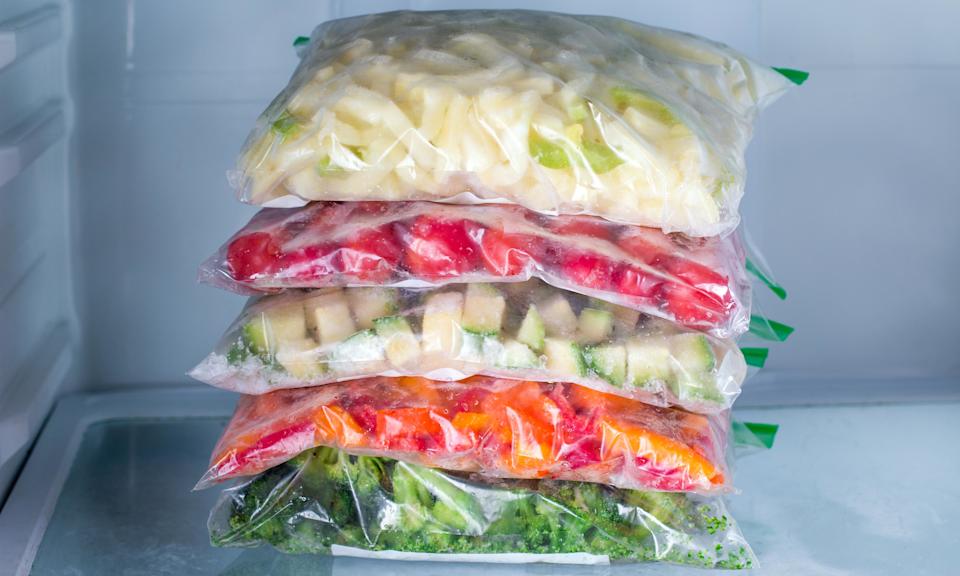Frozen food: expert tips on how to get the best out of your freezer
Kate Hall, the home cooking consultant behind the Full Freezer website, tries to help people get the best out of their freezer, whether that is preserving leftovers or buying frozen in the shops.
At the outset she suggests people keep a notepad beside their food waste or compost bin to keep track of what is being thrown away. This helps identify foods where you could be buying less, Hall says: “Are we just buying things on autopilot that we could take off the shopping list?”
Although Hall’s focus is on avoiding waste rather than buying frozen food per se, she has considered the price differential when it comes to fruit and veg. She found that the rule of thumb is that the more processing is involved, the more expensive it is.
“You can get a pineapple for £1 but if you buy frozen, it is about £5 for 1kg,” she says. “On the flipside, blueberries are about £10 per 1kg fresh but £6 or £7 frozen.”
However, buying frozen veg that costs more than the fresh version – such as chopped onions – may still make sense.
“If somebody is wasting a lot of food when they buy fresh, it might still work out cheaper to buy frozen,” she says.
Hall has lots of ideas on how to prevent food ending up in the bin. “Potatoes are a big, big one,” she says. “We waste 4.4m potatoes every day in the UK.
“You can’t just pop them in the freezer, which is a pain, but you can bake them all at once, then freeze them. They can be reheated in the microwave or made into mash. I freeze mash flat in freezer bags so it’s very quick to defrost and reheat.”
She adds: “Carrots are another one. My favourite thing is to grate them and freeze in a thin layer. Then they can be used to bulk out meals such as bolognese.”
It doesn’t stop there. “Fruits such as bananas can be frozen whole but my advice is to slice them and freeze on a lined baking tray. Once they’re solid, they can be stored in a freezer bag and used for smoothies.”
Finally, an important thing to consider: whether you will taste the difference.
“Everybody’s preferences and sensitivities are different,” Hall says. “Some people will absolutely be like: ‘I can taste freezer on that bread roll.’
“When it comes to shop-bought frozen foods, you simply have to try it out and see how you find it.”
To freeze or not to freeze
So expansive is the list of foods you can freeze – and buy frozen – these days, it’s easier to start with what not to freeze and work backwards.
One good rule of thumb is to avoid freezing foods with a high water content, unless you’re cooking with them. Lettuce and salad vegetables such as cucumbers and radishes will turn soggy on defrosting but almost all vegetables beyond those are freezer-friendly, as long as they are destined for the stove.
Freezing a sofrito mix will stand you in good stead for days you don’t fancy chopping a dozen onions, carrots and celery, and for heaven’s sake, freeze those herbs: they’re easier to manage chopped up and frozen with a little water in ice cube trays or made into a pesto.
The same goes for fruit: if you are cooking or blending, then freeze away, but don’t expect the texture of fresh strawberries to survive a spell in the freezer drawer. Bananas freeze well, if you don’t fancy banana bread – but make sure you peel them first.
Ditto eggs. You can’t freeze eggs in their shells for the same reason you can’t freeze wine in a bottle but you can beat yolk and white together and freeze in a container, or freeze them separately. The Red Lion recommends adding a little salt to your yolks before freezing, to prevent them turning gelatinous – and do remember frozen eggs need to be fully thawed before cooking, which you can do by leaving them in the fridge overnight.
Other unlikely contenders for your freezer include: pasta (cooked), rice (cooked), bread (sliced or crumbed), nuts (chopped) and cheese (grated). Don’t freeze cheese expecting it to be cheeseboard-ready; it won’t retain its sumptuous texture. Neal’s Yard Dairy advises using thawed cheese in cooking, where the taste and texture signify less. On that note, foods with a high milk or cream content – cream, yoghurt, custard, etc –don’t freeze particularly well: sadly, one cannot make frozen yoghurt by just freezing yoghurt any more than just freezing cream makes ice-cream. You can cook with frozen cream but you wouldn’t want to whip it, or pour it over dessert.

As for meat and fish, the usual rules apply. Freeze at its freshest (never after the use-by date) and defrost thoroughly before cooking. You can do that in the microwave but in the fridge overnight is better if possible. Raw meat and fish should never be refrozen after defrosting but you can refreeze once they’re cooked into a dish – just wait for it to reach room temperature first.
They are not cheap to run, and defrosting the freezer is the worst of all chores, it’s true – but used wisely, your freezer will save you food, money and time.

 Yahoo News
Yahoo News 
